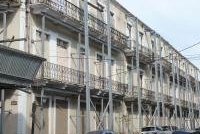Solivagant 2.0
The Colonial Transisthmian Route of Panamá
The Colonial Transisthmian Route of Panamá (Inscribed)

On our previous visit to Panama way back in 1991 neither the ruined Panama Viejo nor the Casco Viejo historic district of Panama City had yet been inscribed. Nevertheless we paid reasonable attention to the former because of its obvious historic interest but the latter seemed to pass us by without us having fully appreciated its possible merits! It had seemed just another colonial centre among many in Latin America and, after a quick perusal, we had moved on to the Canal and to Portobelo in our rentacar! So, in 2012, when we did a transit of the Canal by ship and then had a day at the Balboa end we determined to try to fill in on what we might have missed!
Casco Viejo is set well apart from modern bustling Panama City on a small peninsula surrounded by some of the less salubrious parts of the city. I am not normally one to worry overmuch about “safety warnings” in cities (though I have, possibly as a result, have been mugged twice in my travelling career!) but the district of El Chorillo just to the west of the Casco has a particularly tough reputation as does that of nearby Santa Ana . The former was Noriega’s boyhood neighbourhood, the location of his HQ, the heartland of his populist support and the location of much of the bombing during the US invasion. Our taxi driver emphasized the “peligroso” of the area and had us lock our doors as we passed through!
Over the years the entire area of the Casco and the surrounding neighbourhoods had degenerated into slums but Casco Viejo itself is now undergoing significant investment and gentrification. However, considerable tensions exist, with beautifully restored buildings standing next to shells whose front walls are held up by steel framework (photo). And always just a few blocks away lie real slums. The state of the site has figured in WHC discussions for the last 4 years with “In danger” status being threatened. The latest concern is related to a new highway which will pass right by (or, in one plan, even under) the peninsula and would totally alter Casco Viejo’s relationship to the coast (“Government plans to build a $776 million superhighway — phase III of the coastal beltway mega-project — call for a giant landfill stretching out into the ocean around Casco Viejo, eliminating the neighborhood’s historic maritime boundaries and burying part of its 338-year old seawall beneath a new roadside park.”). The issue is well mired in Panamanian politics with promises of jobs and housing improvements gaining the Government much support for the development plans despite opposition from the wealthier residents of the Casco and environmentalists.
One of the aspects which sets Casco Viejo apart from other Spanish colonial cities is the French influence which arose during the failed de Lesseps attempt to build a canal. The Embassy to this day occupies a commanding position within the Casco at Plaza de Francia (which also has a monument to the 20000 or so French and French colonial workers who died in the attempt) and many of the houses exhibit the wrought iron balconies reminiscent of New Orleans. Even the un-renovated ones possess a certain charm!
The Casco area only covers around 25 small blocks and, as well as many modest residential buildings, contains a cathedral, several churches (operating and ruined), some public buildings (such as the nicely renovated Salon Bolivar , the Presidential Palace and a theatre) and some pleasant plazas. The sea provides the boundary on 3 sides and an esplanade along the sea wall gives fine views across to modern Panama City’s surprisingly tall skyline as well as providing a pitch for numerous Kuna sales ladies from the San Blas islands selling their distinctive “Molas”. Among the churches, that of San Jose is noteworthy for its 16th century “Altar de Oro” supposedly saved from Henry Morgan’s predations on Panama La Vieja and moved to the new town a few years later. One of the ruins you will see is that of Noriaga’s favourite night club – still unreconstructed after its destruction in the 1989 US invasion!
There is no doubt that, when it was inscribed in 1997 Casco Viejo didn’t meet the sort of preservation and management requirements which aspiring sites would be expected to demonstrate today. The nomination dossier states that “only 5% of the buildings in the Historic District are in a reasonable state of conservation, whilst 70% show marked physical or functional deterioration”. ICOMOS and the WHC seemed to accept that a Master plan developed in 1972 and turned into a “Revitalisation plan” in 1995 (but not “officially approved” at the time of inscription) showed adequate intention to do the necessary to preserve and improve the fabric of the site. And perhaps this was the correct decision – sometimes greater leverage can be applied for the improvement of a site if it is already under the UNESCO umbrella than if it is not. But, 15 years after inscription, the main impression we gained from walking around the Casco Viejo today (2012) was still one of significant decrepitude and decay despite examples of urban renewal particularly in the public buildings. However there did indeed seem to be a lot of work going on with a number of buildings shrouded in scaffolding. Panama hopes to be Latin America’s “Singapore” and its economic growth remains well above the Latin American average but there is a long way to go and Casco Viejo and its environs provide an interesting example of the difficulties of balancing economics, politics and the environment in a developing country with much poverty and weak institutions.
Comments
No comments yet.
